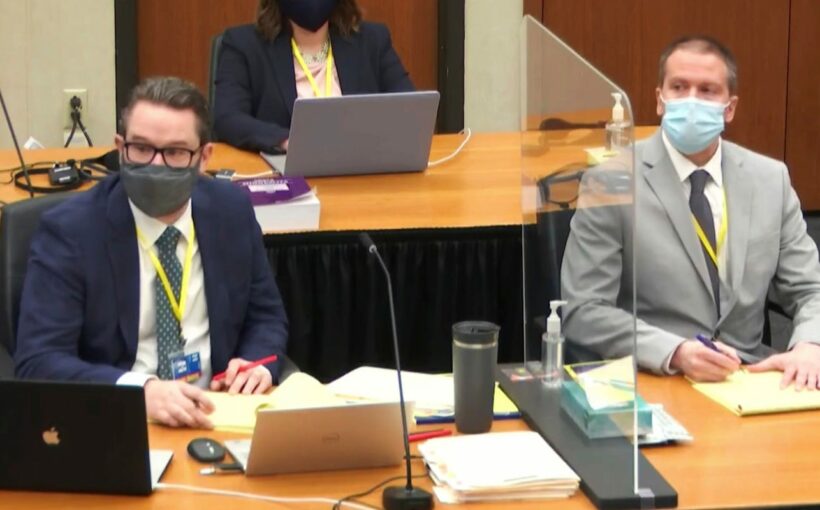MINNEAPOLIS — Jurors will return to the courtroom Monday morning to hear more testimony from witnesses in the trial of former officer Derek Chauvin, charged with George Floyd’s murder.
Last week, jurors heard from 19 people including several who witnessed Floyd’s death and broke down in tears on the stand as they described their attempts to intervene on his behalf. Several Minneapolis police officers, including Chauvin’s supervisor at the time of Floyd’s death, testified about what they saw at the scene after Floyd was arrested, police training and the officers’ use of force on Floyd.
Veteran officer Lt. Richard Zimmerman told the court Friday that kneeling on the neck of a suspect is potentially lethal and there is “absolutely” an obligation to provide medical intervention as soon as necessary. Zimmerman called Chauvin’s use of force on Floyd “totally unnecessary.”
“Holding him down to the ground face down and putting your knee on the neck for that amount of time, is just uncalled for,” he said.
Chauvin is charged with second-degree murder, third-degree murder and second-degree manslaughter. Floyd, a Black man, died in police custody on May 25, 2020, after Chauvin, who is white, pinned his knee against Floyd’s neck for more than nine minutes.
Stay updated on the Derek Chauvin trial: Follow USA TODAY Network reporters on Twitter, sign up for text messages of key updates, or subscribe to the Daily Briefing newsletter.
Scenes from Minneapolis: Anger brews in recovering protest hotspots
From the razor wire ringing the courthouse to the activists still occupying the streets, this is a city still reckoning with the consequences of the death of George Floyd and the high-profile trial of the police officer accused of killing him.
Although the streets are largely empty of protests, there’s long-simmering anger bubbling beneath the surface, and angry calls for justice and reform echo across the city, particularly in the neighborhood where Floyd died. And 10 months after his death, Floyd’s name and face are everywhere, staring down from billboards, scrawled on walls. Depending on the day, and how strictly police decide to enforce the rules, dozens of posters of Floyd’s face gaze up at the Hennepin County Government Center from where they’re hung on the security fences strung with barbed wire.
“We will be here every day and every night until we see some justice,” said protester Ashley Dorelus, 26, one of the people who have occupied the plaza outside the courthouse. “This is a revolution, ladies and gentlemen. It is not a parade.”
The intersection where Floyd died has become a metaphor for the city as a whole: Still grieving, and with no consensus on exactly how to move forward. City officials want to reopen the intersection when the trial’s over. Activists worry allowing that to happen could permit Floyd to become just one more Black man killed by the cops.
Downtown, the fortified government center and courthouse complex is ringed with razor wire and soldiers. For many protesters and reform advocates, the razor wire, armored cars and camouflaged soldiers with rifles are the ultimate expression of the yawning chasm between the government and the people it’s supposed to be representing.
It’s clear from the security precautions that authorities are scared of what might happen if angry crowds once again rampage through the streets demanding justice and reform.
Lake Street bore the brunt of the destruction, as angry residents first attacked the 3rd Precinct police station where Chauvin and his colleagues were based, and then spread out to liquor stores, pharmacies, the Target and Cub foods stores.
Today, rebuilding is underway for some. Target and Cub have reopened, as have most of the liquor stores. While the broken glass has been swept away and the burned-out buildings demolished, scars linger from last summer’s civil unrest and riots.
Floyd opioid drug addiction highlighted in Derek Chauvin trial
Like millions of Americans, George Floyd lived with the torment of drug addiction.
He and his girlfriend, Courteney Ross, became addicted to opioids four years ago after they were both prescribed for chronic pain. When the prescriptions ran out, they turned to illegal drug use. They tried to go clean, then failed. They tried again, but could not stop for long.
As the COVID-19 pandemic spread across the United States, Floyd, the father of two young daughters, started using again: he lost his job as a nightclub security guard because of quarantine shutdowns, he was hospitalized for several days after an overdose, he found out he had the coronavirus. On the day he died, his neck trapped under the knee of former Minnesota police officer Derek Chauvin, he had fentanyl and methamphetamine in his system, toxicology reports later showed.
“We got addicted and tried really hard to break that addiction many times,” Ross said tearfully Thursday during testimony in the Chauvin trial over Floyd’s death.
Courteney Ross, who was in a relationship with George Floyd for about three years, became emotional when discussing their relationship.
Associated Press
Floyd’s death helped launch a global civil rights movement over racial injustice and police violence. His trial could similarly shape how Americans view drug addiction at a time when Black people continue to overwhelmingly be denied medical treatment for addiction compared to white Americans even as they suffer from disproportionately high rates of fatal opioid overdoses.
Chauvin’s defense attorney, Eric Nelson, has sought to persuade jurors that drugs – not Chauvin’s knee clamping down on Floyd’s neck as he cried “I can’t breathe” while handcuffed on the ground – contributed to Floyd’s death.
Prosecutors, family members and medical experts have said Floyd’s history of addiction does not explain how he died. Chauvin, who is white, is charged with second-degree murder, third-degree murder and second-degree manslaughter in the death of Floyd, a 46-year-old Black man.
Source: Read Full Article
